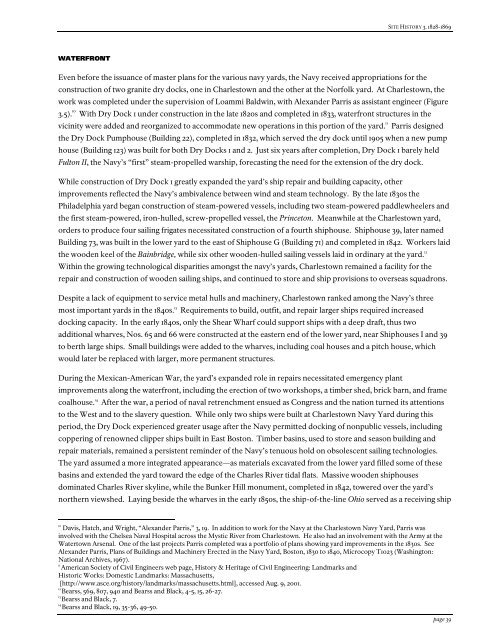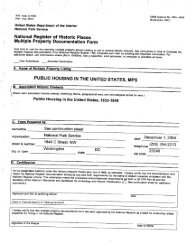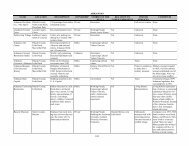Cultural Landscape Report for Charlestown Navy Yard, Boston
Cultural Landscape Report for Charlestown Navy Yard, Boston
Cultural Landscape Report for Charlestown Navy Yard, Boston
You also want an ePaper? Increase the reach of your titles
YUMPU automatically turns print PDFs into web optimized ePapers that Google loves.
WATERFRONT<br />
SITE HISTORY 3. 1828-1869<br />
Even be<strong>for</strong>e the issuance of master plans <strong>for</strong> the various navy yards, the <strong>Navy</strong> received appropriations <strong>for</strong> the<br />
construction of two granite dry docks, one in <strong>Charlestown</strong> and the other at the Norfolk yard. At <strong>Charlestown</strong>, the<br />
work was completed under the supervision of Loammi Baldwin, with Alexander Parris as assistant engineer (Figure<br />
3.5). 10 With Dry Dock 1 under construction in the late 1820s and completed in 1833, waterfront structures in the<br />
vicinity were added and reorganized to accommodate new operations in this portion of the yard. 11 Parris designed<br />
the Dry Dock Pumphouse (Building 22), completed in 1832, which served the dry dock until 1905 when a new pump<br />
house (Building 123) was built <strong>for</strong> both Dry Docks 1 and 2. Just six years after completion, Dry Dock 1 barely held<br />
Fulton II, the <strong>Navy</strong>’s “first” steam-propelled warship, <strong>for</strong>ecasting the need <strong>for</strong> the extension of the dry dock.<br />
While construction of Dry Dock 1 greatly expanded the yard’s ship repair and building capacity, other<br />
improvements reflected the <strong>Navy</strong>’s ambivalence between wind and steam technology. By the late 1830s the<br />
Philadelphia yard began construction of steam-powered vessels, including two steam-powered paddlewheelers and<br />
the first steam-powered, iron-hulled, screw-propelled vessel, the Princeton. Meanwhile at the <strong>Charlestown</strong> yard,<br />
orders to produce four sailing frigates necessitated construction of a fourth shiphouse. Shiphouse 39, later named<br />
Building 73, was built in the lower yard to the east of Shiphouse G (Building 71) and completed in 1842. Workers laid<br />
the wooden keel of the Bainbridge, while six other wooden-hulled sailing vessels laid in ordinary at the yard. 12<br />
Within the growing technological disparities amongst the navy’s yards, <strong>Charlestown</strong> remained a facility <strong>for</strong> the<br />
repair and construction of wooden sailing ships, and continued to store and ship provisions to overseas squadrons.<br />
Despite a lack of equipment to service metal hulls and machinery, <strong>Charlestown</strong> ranked among the <strong>Navy</strong>’s three<br />
most important yards in the 1840s. 13 Requirements to build, outfit, and repair larger ships required increased<br />
docking capacity. In the early 1840s, only the Shear Wharf could support ships with a deep draft, thus two<br />
additional wharves, Nos. 65 and 66 were constructed at the eastern end of the lower yard, near Shiphouses I and 39<br />
to berth large ships. Small buildings were added to the wharves, including coal houses and a pitch house, which<br />
would later be replaced with larger, more permanent structures.<br />
During the Mexican-American War, the yard’s expanded role in repairs necessitated emergency plant<br />
improvements along the waterfront, including the erection of two workshops, a timber shed, brick barn, and frame<br />
coalhouse. 14 After the war, a period of naval retrenchment ensued as Congress and the nation turned its attentions<br />
to the West and to the slavery question. While only two ships were built at <strong>Charlestown</strong> <strong>Navy</strong> <strong>Yard</strong> during this<br />
period, the Dry Dock experienced greater usage after the <strong>Navy</strong> permitted docking of nonpublic vessels, including<br />
coppering of renowned clipper ships built in East <strong>Boston</strong>. Timber basins, used to store and season building and<br />
repair materials, remained a persistent reminder of the <strong>Navy</strong>’s tenuous hold on obsolescent sailing technologies.<br />
The yard assumed a more integrated appearance—as materials excavated from the lower yard filled some of these<br />
basins and extended the yard toward the edge of the Charles River tidal flats. Massive wooden shiphouses<br />
dominated Charles River skyline, while the Bunker Hill monument, completed in 1842, towered over the yard’s<br />
northern viewshed. Laying beside the wharves in the early 1850s, the ship-of-the-line Ohio served as a receiving ship<br />
10<br />
Davis, Hatch, and Wright, “Alexander Parris,” 3, 19. In addition to work <strong>for</strong> the <strong>Navy</strong> at the <strong>Charlestown</strong> <strong>Navy</strong> <strong>Yard</strong>, Parris was<br />
involved with the Chelsea Naval Hospital across the Mystic River from <strong>Charlestown</strong>. He also had an involvement with the Army at the<br />
Watertown Arsenal. One of the last projects Parris completed was a portfolio of plans showing yard improvements in the 1830s. See<br />
Alexander Parris, Plans of Buildings and Machinery Erected in the <strong>Navy</strong> <strong>Yard</strong>, <strong>Boston</strong>, 1830 to 1840, Microcopy T1023 (Washington:<br />
National Archives, 1967).<br />
11<br />
American Society of Civil Engineers web page, History & Heritage of Civil Engineering: Landmarks and<br />
Historic Works: Domestic Landmarks: Massachusetts,<br />
[http://www.asce.org/history/landmarks/massachusetts.html], accessed Aug. 9, 2001.<br />
12<br />
Bearss, 569, 807, 940 and Bearss and Black, 4-5, 15, 26-27.<br />
13<br />
Bearss and Black, 7.<br />
14<br />
Bearss and Black, 19, 35-36, 49-50.<br />
page 39







